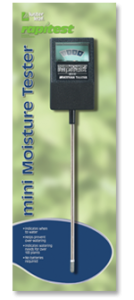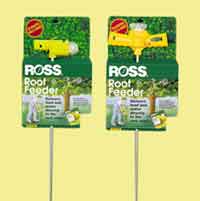1) What can I do about a tree that sends up suckers all over my yard?
If you’re not happy just mowing those suckers down with the grass, try a product we carry called Sucker punch RTU. It’s a plant growth regulator that can be used on any tree that suckers as well as on fruit trees.
2) Do you carry (fill in the blank) plant?
We have all the common landscape and edible plants plus many that aren’t so common. All grow well in Colorado. If you’re looking for something unusual, come into the store and we would love to help you find it!!
3) What’s wrong with my plant?
 See our Information Desk for help diagnosing your plant problems. Most plants that are growing poorly are either getting too much or too little water. We recommend the use of a Rapitest moisture meter that has a 1 – 4 gauge. Just stick the rod in the soil and the meter will point to a number 1 to 4. For most established plants, shoot for the slightly moist reading (in the low “2” range) before you water. For drought-resistant plants, you’ll want to wait until the soil is dry and the needle points to “1.”
See our Information Desk for help diagnosing your plant problems. Most plants that are growing poorly are either getting too much or too little water. We recommend the use of a Rapitest moisture meter that has a 1 – 4 gauge. Just stick the rod in the soil and the meter will point to a number 1 to 4. For most established plants, shoot for the slightly moist reading (in the low “2” range) before you water. For drought-resistant plants, you’ll want to wait until the soil is dry and the needle points to “1.”
4) How do I plant a rose, tree or shrub?
You’ll need a shovel and a few other things. Please see our Planting and Warranty Guide.
5) How often do I water my plants?
The general (and not particularly helpful) answer is “as needed.” How often to water depends on several factors: air temperature, soil type, plant needs (high-water versus low-water), location and whether your plant is well-established or newly planted. The best answer is to stick a moisture meter (see question 3) in the ground to see how dry the soil is. Be sure to go deep enough to reach the soil around the bulk of the root ball. In general:
- Plants in containers need to be watered more frequently; plants in the ground with mulch over the soil need less watering.
- Plants in poor soils (soils with little organic matter) need more; well-amended soils hold water better.
- Plants receiving southern or western sun need more water; plants on the north and east side of your house need less. Likewise, plants located in shady areas need less.
- Plants in windy areas dry out quicker due to transpiration of moisture through the leaves; plants in protected areas lose less moisture via transpiration.
- Plants located next to a reflective surface (your house’s brick or siding) need more water; plants surrounded by other plants need less.
- Well-established plants (3 years and older) need less water; new plants need frequent watering to help the roots grow.
- Plants with low water requirements (xeric plants) should not be watered until the soil is dry; high-water plants need to be watered before the soil dries out.
6) I want to plant some annuals in a pot. What are some good plant combinations?
There are so many choices in our Annual Department that choosing the best plant combinations can be a bit overwhelming. Will your pot be in the sun for 6 hours or more? If yes, wander into our Sunny Annuals section. If no, stroll through the Shady Annuals. Do you have a favorite plant or color? Start with that plant and then choose plants with contrasting or complementary colors. You’ll want something tall for the center or back of the pot. Then look for annuals of varying heights to fill in around it. Finally, choose a few plants that trail over the edge of the pot. Consider leaf color in addition to bloom color. Try a silvery trailer next to a bright pink bloom or a dark purple leaf. Do you like something dramatic like bright yellow with deep purple; or something more subdued with pale yellow and lavender? You really can’t go wrong! (Don’t over-think it!) If you need inspiration, wander through our front display pots to get some ideas. Still stuck? Just ask us; we’ll be happy to help you pick out the right combinations!
7) How do I water my plants in the winter?
 Trees, shrubs, lawns and perennials need water at the root zone, 6 to 8 inches down. You can water as long as the ground is not frozen and daytime temps are above 40 degrees. Check to see if the ground is frozen by inserting a screw driver. We recommend a Ross Deep Root Feeder attached to a hose for watering trees and shrubs. If you need to water the lawn and your trees, you can hit them both with a sprinkler attached to the hose. Let the sprinkler run for about 45 minutes to an hour in each area. Check every 15 minutes. If water is running off the area, move the sprinkler and let the water soak in for at least 15 minutes. After the water has soaked in you can water again in 15 increments until you’ve reach 45 minutes to one hour. Be sure to check the moisture in the soil each month and water as needed. Don’t be fooled by snowfall as dry snows typically have little moisture content.
Trees, shrubs, lawns and perennials need water at the root zone, 6 to 8 inches down. You can water as long as the ground is not frozen and daytime temps are above 40 degrees. Check to see if the ground is frozen by inserting a screw driver. We recommend a Ross Deep Root Feeder attached to a hose for watering trees and shrubs. If you need to water the lawn and your trees, you can hit them both with a sprinkler attached to the hose. Let the sprinkler run for about 45 minutes to an hour in each area. Check every 15 minutes. If water is running off the area, move the sprinkler and let the water soak in for at least 15 minutes. After the water has soaked in you can water again in 15 increments until you’ve reach 45 minutes to one hour. Be sure to check the moisture in the soil each month and water as needed. Don’t be fooled by snowfall as dry snows typically have little moisture content.

